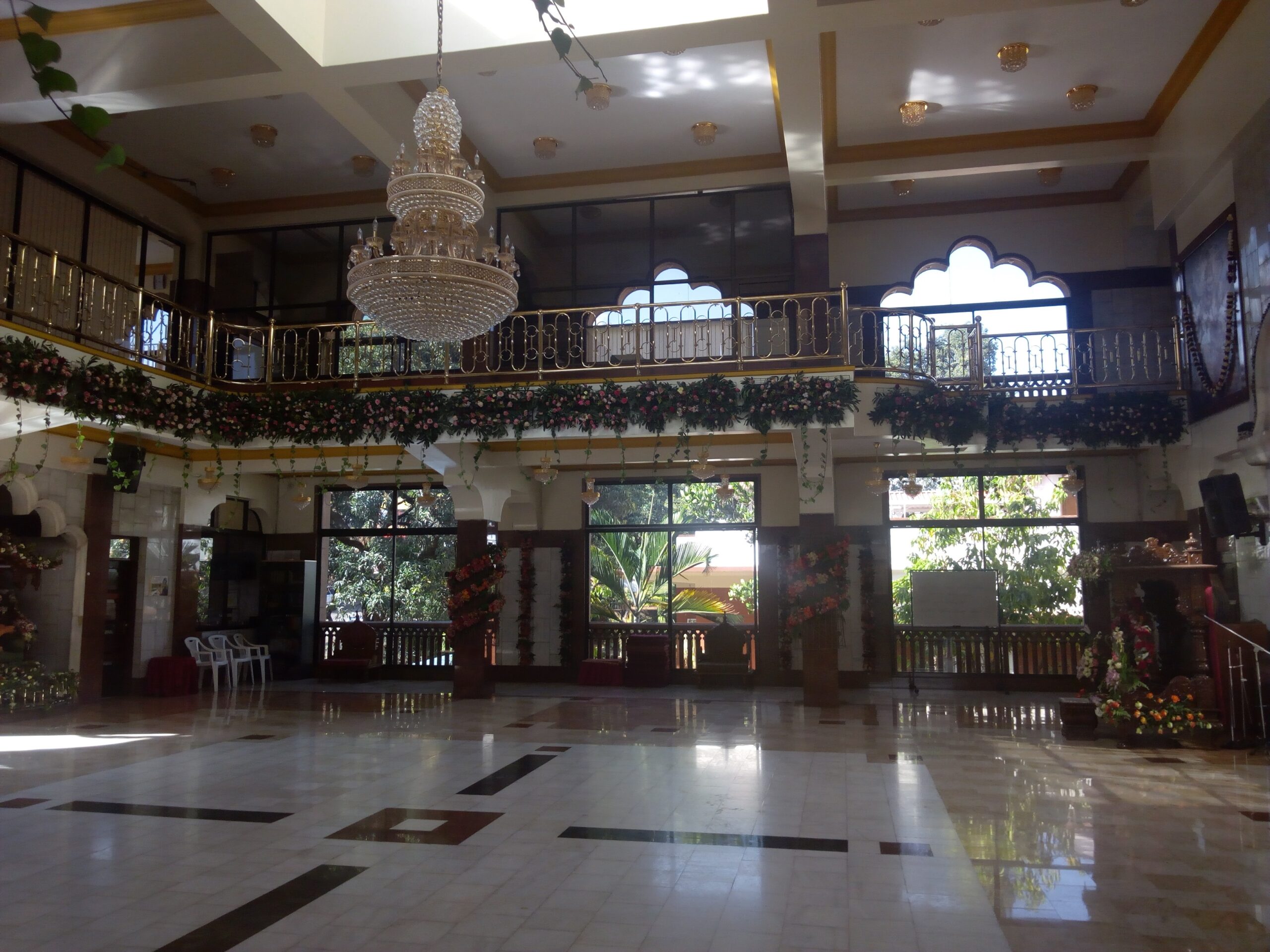TO WONDER…
As a faithful lover of science, experiments are my prayers, my toil in study is my worship, discoveries are my offering and the laboratory is the cathedral of my soul. I had never imagined, ever since I was a little primary school boy, that I would one day set foot in a Hindu temple. But when I finally sat cross-legged upon a cold, concrete floor, surrounded by dutiful devotees – happily and gracefully chanting the transcendental Maha Mantra – and when I tasted the ambrosial sweetness of Krsna’s Prasadam, I was reminded that despite its countless sins, religion can be sweet, tender and beautiful.
The most curious quality of the human mind is that little voice that chatters endlessly within your head. It is the creator of elegant equations and the passages of our mythologies; it is the author of our fears and the personages of our dreams. It can neither be summoned nor driven away. It dispels the quietude in our minds when we try to meditate, and keeps us up at night when we desire sleep. I have lost my way on many occasions, wandering far from home while debating ferociously with this little voice. Each morning, whenever I rushed past the temple on my way to another boring UoN lecture, or as I went about my errands, this little voice beseeched me to slow down, turn my head and take a good look at the magnificent structure in the distance, for just a little bit longer. Never mind the silly whispers of my fellows that therein, cows were the object of worship, or that I may anger anew a God I had long abandoned. I always longed to enter it, yet I never did even when I passed by its gates for the thousandth time.
The arches of its windows, the lotus shades of its motifs and geometric symmetry of its symbolisms arrested my thoughts ever since I first laid my eyes on them, yet the caution of introversion stayed my hand from approaching the temple. The nature of my folly has always been timidity. I am too afraid to feel, to give in to the pleasures of life and ‘drink till my lips want no more’. When confronted with a thing of wonder and great beauty, though my palm will sweat and itch and crave to touch, my mind would never yield. It is wiser, says my mind, to let a radiant rose blossom in the field, unmolested by my touch, than to watch it wither and die within my grasp.
The temple stands on the Ngara-road hillside like an innocent stranger caught between battle lines. It is a modest structure by ‘temple standards’, built on an immodest landscape. Its length hardly spans the range of a boy’s stone throw, and its breadth would scarcely task a crawling child. To the left, it abuts majestic spoils of blind capitalism, money laundering, tax evasion, bribes, embezzlement, insider trading, scams and economic sabotage: high-end flats, expensive clubs, shady business enterprises and brothels — all which the devotees call Maya, the illusory energy of the ‘material world‘. To the right, it overlooks the collateral damage of these vices: dilapidated suburban housing, of moldy walls and rotting doors, rusty and littered rooftops, illegal ‘makaa’ joints, open-air garages, mama pima (shack) hotels, homelessness and violent crime. It is on this impoverished side that an electric fence has been erected over 10 feet high. Yet on thieving tycoons’ side, only a few trees, short bushes and a scalable fence mark the divide.
For years, I had cast a longing eye onto the structure. I felt my heart beckoned by the melodies and the sweet scents of burning incense that wafted from within. What things are hid, what secrets concealed, and what wondrous culture lives within its walls? What majestic art and flights of poetry still remain hidden from me in its ancient manuscripts, as fossils from an older world? I wondered. As the pleasure of indulgence is often lessened by endless anticipation, I eventually decided to walk towards it.
It was on an unremarkable evening. The night had fallen fast, and I had just emerged from a narrow path that cut through the larger of the Kariuwa slums. It is sandwiched between two long stretches of dilapidated apartments, and none but a proper Nairobian, who ‘rushes in where angels fear to tread’, knows how to find it. It is here that some of the young mothers who beg for coins on Waayaki way during the traffic jams — forgotten by an evil and gluttonous government — live.
As one approaches the slum, they are immediately confronted with its largest structure: a church, constructed out of rusty iron sheets and chicken wire. As you walk around the church, following the slum’s singular path, the horrid smell of 4 communal toilets, shared by over 200 people, bids you welcome. Right next to it stands the communal dustbin, which is nothing more than a large heap of fermenting garbage that is collected by the county government once every solar eclipse. A meter from that, stands the smallest school I have ever seen. Two rooms serve as its classrooms, and a veranda barely 2 metres wide and 10 metres long is its playground. The slums only drainage is a shallow and uneven ditch that runs along the wall, and as one wanders deeper into the slum where two chains of shacks are erected side by side, the ditch runs right in between them. It isn’t uncommon to see a child reaching into its murky waters to extract a fallen toy, the same waters in which people spit and discard domestic waste, and on occasion, drunkards deposit their foul golden fluids.
On that fateful day, after my customary visit to mathe’s shack in deepest reaches of the slum – where hundreds of Nairobians, from the magnate to the pauper, would pilgrimage every day, in search of communion and an assortment of trusted medicants for their delectation – came an announcement from Brayo that every lad loves to hear: “Buda leo niko na form!” [Man, today I’ve got something good!]
“Form gani?” [What?] came the synchronized response from our small gang.
“Mzinga ya Legend, lakini kwanza twende tudishi.“[A litre of Legend brandy, but first lets head out to eat]. The munches had started setting in.
“Si kwa Wanyoike wamefunga?”[Isn’t Wanyoike’s joint closed?] I asked, looking at the time. Our usual joint, a wooden structure at the roadside that has now been torn down by the county government, would be deserted at that hour.
“Haina ngori. Vas leo twende tudishi Hare,”[No problem. Vas let’s go feast at the Hare Krishna’s today]
“Ah, zii,” I declined, as usual. “Sipendi hiyo baze.” [Ah, no. I don’t like that place]
“Wacha ufala brathe, kwani huwa unaogopa nini?” [Stop being silly, bro. What is it you always fear?] he insisted, pushing me towards it.
Brayo, like millions of others who live close to the over 100 Hare Krishna temples across the world, was a beneficiary of the ‘food for life’ program. Following the instruction of the movement’s Acharya [leader/founder/teacher], the late A.C. Bhaktivedanta Swami Srla Prabhupad, that ‘nobody should go hungry within a 10-mile radius of an ISKCON temple’, the Ngara Temple had developed a nice tradition of providing undergraduates and passersby with a warm, sumptuous meal soon after an hour’s lecture on ethics and morality. Every Wednesday and Saturday, over a hundred people would flood into the temple at 8 pm to endure the boredom of the unfamiliar ancient Sanskrit texts, all in return for a good meal. You must admit that it is quite a reasonable bargain, especially when you have burnt through half of your alloted student’s loan only a month into the semester on alcohol, SportPesa, and the whims of a cheating girlfriend.
“Bado tunanuka ndom msee,” I protested to no avail. There was no turning back.
I approached it with the timidity of a little child. Every step was slow, burdened by many thoughts, never too hasty to betray my attraction to it. I, a passerby, would but briefly linger there, fill my belly and never return – or so I thought.
The upper entrance to the temple was revealed after an oblique flight of stairs that ascends to a large step. Here, one must cast aside their shoes. Onward stretches a second flight of stairs, from the large step to the foot of the majestic, brass-plated wooden door, which offers proper ingress and egress to this spiritual world. On each side of this entrance, stand the four-handed Jaya-Vijaya, the two Dvarapalas (gate keepers) of the spiritual world.

It is here that you must stand in order to cast your bewildered gaze into the central sanctum, which enshrines a great consortium of Vedic gods, dressed in flowers and golden embroidery. As is the custom of devotees, one must touch the feet of the gate keepers, the blue-skinned Jaya and Vijaya, and offer proper obeisance before matching in.
The soles of my feet have since then kissed the scented floor outstretched before these gods thousands of times, gods far much older than your own. My tongue has sang their ancient songs, my ears have relished the melodies of ancient rituals and my mind has been becalmed by the mellow tones of meditative prayers. I have thrown myself at the feet Krishna, offered my obeisance, and pondered the mysteries of this ancient universe. Although it may seem that I have ‘sold my soul’ to the Vedic gods, nothing else could be further from the truth. The Vedic gods have merely borrowed a few brief moments of my time, in exchange for a chance to imagine, to wonder, and to explore the mysteries that lie hidden within an unfamiliar world. It is the function of new ideas, feelings and sensations to stir your mind into the now, to remind you to live rather than to exist, and to make you feel like a child again. In this, the Hare Krishnas have truly succeeded.



Due to the embarrassment that you keep causing me. I shall therefore cease to write and concentrate on developing my other talents.
Yours truly
E.G
It is Alexander Pope, I believe, that said, “..pensive poets painful vigils keep,
Sleepless themselves to give their readers sleep.”
It is to bring beauty to my readers too that I write, and to write I must. If by a similar desire you are compelled, do not protest and abandon me on this lonely path. Write, write, and by the grace of our words we shall expel the misery from the hearts of mankind
Its pieces like these that make civilization worth it
Envisioning your story was easy for i have walked the road you speak of but would never say it better but i must attemp. Miungu hizaliwa ndani yetu, kaa ukitafsiri hilo.